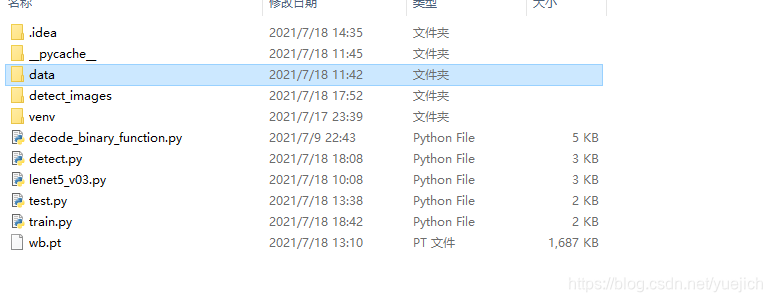利用pytorch实现lenet5网络模型
写在前面:
利用框架搭建模型相对比较简单,但是也会遇到很多问题,网上资料很多,搭建模型的方法大同小异,但是在我尝试了用两种方法搭建出来模型,无论是训练还是检测都会遇到很多的问题,像这种自己遇到的问题,请教别人也没有用。大多数资料上面都是用torch自带的mnist下载数据集,这样自己就跳过了数据整理这个阶段,虽然能训练,并且出来很好的结果,但总归不是自己整理的数据,对于新手朋友来说,就很难图形化的查看自己手写的图片的预测结果。

这个是我的项目文件夹结构
第一步:用pytorch框架搭建lenet5模型
首先需要熟悉lenet5的结构,它是检测手写数字,手写数字图像是28*28大小的一个单通道图片,
第一层为卷积层+池化层:conv2d+maxpool
利用卷积,卷积核大小为5*5,padding为0,stride为1,卷积核数量为20
in_channel=1
out_channel=20
kernel_size=5
stride=1
self.conv1=nn.Conv2d(in_channels=1,out_channels=20,kernel_size=5,stride=1)
池化为最大池化
self.pool1=nn.MaxPool2d(2)
第二层为卷积层+池化层:conv2d+maxpool
和第一层一样,第二层的输入就是第一层的输出
in_channel=20
out_channel=50
kerne_size=5
stride=1
self.conv2=nn.Conv2d(in_channels=20,out_channels=50,kernel_size=5,stride=1)
第二层池化
self.pool2=nn.MaxPool2d(2)
第三层和第四层为全连接层Linear
in_features=800
为什么是800
第一层卷积后得到特征图的大小为(W-F+2P)/S+1=2424,数量20个
第一层池化后得到特征图大小为1212,数量20
第二层卷积后得到特征图的大小为(W-F+2P)/S+1=88,数量50
第二层池化后得到的特征图大小为44,数量50
把50个44的特征图reshape成一个1维数组,就是44*50=800
第三层全连接层输出维500,
最后一层输出为10
self.fc1=nn.Linear(in_features=800,out_features=500,bias=True)
self.relu1=nn.ReLU()
self.fc2=nn.Linear(in_features=500,out_features=10,bias=True)
self.relu2=nn.ReLU()
下面我贴出用pytorch搭建的lenet5网络模型
'''
首先介绍一下这个py文件,文件名为lenet5_v03,版本为v03,因为之前我已经用被的方法复现过两次lenet5算法,这次是第三次,就给这个文件命名为v03。
这个文件是定义一个类class,这个类定义一下LeNet5网络模型,这个网络模型是基于pytorch框架的。
这里面定义了两个模型,我认为是同样的模型的两种书写方式,
'''
import torch
from torch import nn
from torch.nn import functional as F
class LeNet5(nn.Module):
def __init__(self):
super().__init__()
self.cnn_layers=nn.Sequential(
#定义卷积层,1个输入通道,6个输出通道,5*5的卷积filter
nn.Conv2d(in_channels=1,out_channels=20,kernel_size=5,stride=1),
nn.MaxPool2d(2),
#the second cnn_layer,input 20 feature map,output 50 feature map,kernel_size=5,stride=1
nn.Conv2d(in_channels=20,out_channels=50,kernel_size=5,stride=1),
nn.MaxPool2d(2)
)
self.fc_layers=nn.Sequential(
# 3 full connect layers
nn.Linear(800,500),
nn.ReLU(),
nn.Linear(500,10),
nn.LogSoftmax(dim=1)
)
def forward(self,x):
#the forward function
out=self.cnn_layers(x)
out=out.view(-1,800)
out=self.fc_layers(out)
return out
class LeNet5_01(nn.Module):
def __init__(self):
super().__init__()
self.conv1=nn.Conv2d(in_channels=1,out_channels=20,kernel_size=5,stride=1)
self.pool1=nn.MaxPool2d(2)
#the second conv input 20,output 50 kernel_size=5,stride=1
self.conv2=nn.Conv2d(in_channels=20,out_channels=50,kernel_size=5,stride=1)
self.pool2=nn.MaxPool2d(2)
# the full connect
self.fc1=nn.Linear(in_features=800,out_features=500,bias=True)
self.relu1=nn.ReLU()
self.fc2=nn.Linear(in_features=500,out_features=10,bias=True)
self.relu2=nn.ReLU()
def forward(self,x):
x=self.conv1(x)
x=self.pool1(x)
x=self.conv2(x)
x=self.pool2(x)
x=x.view(-1,800)
x=self.fc1(x)
x=self.relu1(x)
x=self.fc2(x)
x=self.relu2(x)
x=F.log_softmax(input=x,dim=1)
return x
上面的代码用了两种方式搭建了模型,分别是LeNet5和LeNet5_01
第二步:数据集整理
这里我不用pytorch自己下载数据集,这里我从网上下载mnist数据集
首先介绍一下mnist数据集

这里是我下载的mnist数据集的二进制文件,总共是4个文件,分别是训练集,训练集标签,测试集,测试集标签,其中训练集为60000张图片,测试集为10000张图片,同时对应的标签为60000个和10000个
图片信息是以二进制的格式保存在这四个文件中的,下面我们需要创建方法读取二进制文件中的内容
'''
解码二进制文件的函数
用来解码MNIST数据集里面的二进制文件
'''
import struct#struct模块
import numpy as np #numpy包
def decode_idx3_ubyte(idx3_ubyte_file):
"""
解析idx3文件的通用函数
:param idx3_ubyte_file: idx3文件路径
:return: 数据集
"""
# 读取二进制数据
with open(idx3_ubyte_file, 'rb') as bin_data1:
bin_data=bin_data1.read()
# 解析文件头信息,依次为魔数、图片数量、每张图片高、每张图片宽
offset = 0
fmt_header = '>4i'
'''使用大端法'''
#mnist使用的大端方法存储的数据
# 因为数据结构中前4行的数据类型都是32位整型,所以采用i格式,但我们需要读取前4行数据,所以需要4个i。我们后面会看到标签集中,只使用2个ii。
magic_number, num_images, num_rows, num_cols = struct.unpack_from(fmt_header, bin_data, offset)
print('魔数:%d, 图片数量: %d张, 图片大小: %d*%d' % (magic_number, num_images, num_rows, num_cols))
# 解析数据集
image_size = num_rows * num_cols
# 获得数据在缓存中的指针位置,从前面介绍的数据结构可以看出,读取了前4行之后,指针位置(即偏移位置offset)指向0016。
print(struct.calcsize(">4i"))
offset =offset+ struct.calcsize(fmt_header)
print(offset)
# 图像数据像素值的类型为unsigned char型,对应的format格式为B。这里还有加上图像大小784,是为了读取784个B格式数据,如果没有则只会读取一个值(即一副图像中的一个像素值)
#B是一个字节8为,I是4个字节32位
fmt_image = '>' + str(image_size) + 'B'
print(fmt_image,offset,struct.calcsize(fmt_image))
#1万张图片
images = np.empty((num_images, num_rows, num_cols))
#plt.figure()
#j=0
for i in range(num_images):
if (i + 1) % 10000 == 0:
print('已解析 %d' % (i + 1) + '张')
print(offset)
#读取数据放入第i行,并reshape(28,28)
images[i] = np.array(struct.unpack_from(fmt_image, bin_data, offset)).reshape((num_rows, num_cols))
#print("输出",images[i])
offset += struct.calcsize(fmt_image)
#plt.imshow(images[i],'gray')
#不明白是什么意思
#plt.pause(0.001)
#plt.show()
#plt.show()
return images
def decode_idx1_ubyte(idx1_ubyte_file):
"""
解析idx1文件的通用函数
:param idx1_ubyte_file: idx1文件路径
:return: 数据集
"""
# 读取二进制数据
with open(idx1_ubyte_file, 'rb') as bin_data1:
bin_data=bin_data1.read()
# 解析文件头信息,依次为魔数、图片数量、每张图片高、每张图片宽
offset = 0
fmt_header = '>2i'
'''使用大端法'''
#mnist使用的大端方法存储的数据
# 因为数据结构中前4行的数据类型都是32位整型,所以采用i格式,但我们需要读取前4行数据,所以需要4个i。我们后面会看到标签集中,只使用2个ii。
magic_number, num_labels = struct.unpack_from(fmt_header, bin_data, offset)
print('魔数:%d, 图片标签数量: %d个' % (magic_number, num_labels))
# 解析数据集
label_size = 1
# 获得数据在缓存中的指针位置,从前面介绍的数据结构可以看出,读取了前4行之后,指针位置(即偏移位置offset)指向0016。
print(struct.calcsize(">2i"))
offset =offset+ struct.calcsize(fmt_header)
print(offset)
# 图像数据像素值的类型为unsigned char型,对应的format格式为B。这里还有加上图像大小784,是为了读取784个B格式数据,如果没有则只会读取一个值(即一副图像中的一个像素值)
#B是一个字节8为,I是4个字节32位
fmt_label = '>' + str(label_size) + 'B'
print(fmt_label,offset,struct.calcsize(fmt_label))
#1万张图片
labels = np.empty((num_labels, 1))
#plt.figure()
j=0
for i in range(num_labels):
labels[i] = np.array(struct.unpack_from(fmt_label, bin_data, offset)).reshape(1)
#print("输出",images[i])
offset += struct.calcsize(fmt_label)
#plt.imshow(images[i],'gray')
#不明白是什么意思
#plt.pause(0.001)
#plt.show()
#plt.show()
return labels
上面的代码就是两个方法,一个是读取图片,并转换成ndarray数组,一个是读取labels,转换成ndarray数组,并返回数据
第三步:训练方法train(),训练数据
下面是文件train.py的代码
#author:chenchen
import torch as t
import numpy as np
from lenet5_v03 import LeNet5_01,LeNet5
from torch.utils.data import DataLoader,TensorDataset
from decode_binary_function import decode_idx3_ubyte,decode_idx1_ubyte
#定义一个train方法,训练模型
def train(EPOCH,model,train_dl):
model.train()
print('_'*10,"训练开始",'_'*10)
print("model's state_dict:")
for param_tensor in model.state_dict():
print(param_tensor,"\t",model.state_dict()[param_tensor].size())
loss=t.nn.CrossEntropyLoss()
opt=t.optim.Adam(model.parameters(),lr=1e-3)
for e in range(EPOCH):
print("run in EPOCH:%d"%e)
for i,(x_train,y_train) in enumerate(train_dl):
x_train=x_train.cuda()
y_train=y_train.cuda()
y_pred=model.forward(x_train)
train_loss=loss(y_pred,y_train)
if (i+1)%100==0:
print('batch:',i+1,train_loss.item())
opt.zero_grad()
train_loss.backward()
opt.step()
t.save(model.state_dict(),'wb.pt')
print('*'*10,'训练完毕','*'*10)
#主程序
if __name__=="__main__":
print('*' * 10,'程序开始执行......','*'*10)
EPOCH = 50
batch_size=32
train_images_path=r"data/train-images-idx3-ubyte"
train_labels_path=r"data/train-labels-idx1-ubyte"
train_images=decode_idx3_ubyte(train_images_path)
train_labels=decode_idx1_ubyte(train_labels_path)
train_images=train_images.reshape(60000,1,28,28).astype(np.float32)/255-0.5/0.5
train_labels=train_labels.reshape(60000).astype(np.long)
train_images=t.from_numpy(train_images)
train_labels=t.from_numpy(train_labels).type(t.long)
#print(train_images[0])
train_ds=TensorDataset(train_images,train_labels)
model = LeNet5().cuda()
train_dl=DataLoader(dataset=train_ds,batch_size=batch_size,shuffle=True,drop_last=False)
train(EPOCH, model,train_dl)
这里的代码主要定义了一个train方法,主程序就是加载数据,把数据转换成tensor,合并train和label为dataset,然后加载数据,
整个过程中用到的torch自带的数据集处理工具
重要应该理解的就是TensorDataset,DataLoader,这两个方法,代码我都是一步一步写的,可以很清晰的了解这两个方法的使用。
最后保存训练好的权重文件为wb.pt
第四步 test(),计算准确率
下面的就是test.py 这个文件的内容
#author=chenchen
import numpy as np
import torch as t
from torch.utils.data import TensorDataset,DataLoader
from lenet5_v03 import LeNet5,LeNet5_01
from decode_binary_function import decode_idx1_ubyte,decode_idx3_ubyte
#定义一个测试方法
def test(model,test_dl,wt):
print("测试开始:")
total=0
correct_count=0
model.eval()
model.load_state_dict(t.load(wt))
for i,(x_test,y_test) in enumerate(test_dl):
pred_labels=model(x_test.cuda())
predicted=t.max(pred_labels,1)[1]
correct_count=correct_count+(predicted==y_test.cuda()).sum()
total=total+len(y_test)
print('total acc:%.2f\n'%(correct_count/total))
if __name__=="__main__":
model = LeNet5().cuda()
test_images_path = r"data/t10k-images-idx3-ubyte"
test_labels_path = r"data/t10k-labels-idx1-ubyte"
test_images = decode_idx3_ubyte(test_images_path)
test_labels = decode_idx1_ubyte(test_labels_path)
test_images = test_images.reshape(10000, 1, 28, 28).astype(np.float32) / 255 - 0.5 / 0.5
test_labels = test_labels.reshape(10000).astype(np.long)
test_images = t.from_numpy(test_images)
test_labels = t.from_numpy(test_labels).type(t.long)
test_ds = TensorDataset(test_images, test_labels)
test_dl = DataLoader(dataset=test_ds, batch_size=62, shuffle=True)
wt = "wb.pt"
test(model=model, test_dl=test_dl, wt=wt)
这个和训练类似,也是需要加载数据,构造加载器,加载模型,加载好训练好的权重文件,然后输入test的数据集,计算预测值
这里用的一个方法就是加载训练好的权重文件
第五步:detect(),可视化测试模型
这个文件名为detect.py
#author=chenchen
import matplotlib.pyplot as plt
from PIL import Image
import numpy as np
from lenet5_v03 import LeNet5
import torch as t
import cv2
def detect(model,image):
print("预测开始:")
model.eval()
wt='wb.pt'
model.load_state_dict(t.load(wt))
image=t.from_numpy(image)
pred_labels=model(image.cuda())
predicted=t.max(pred_labels,1)[1].cpu()
print(type(predicted))
print(predicted.shape)
num=predicted.numpy()
print("num:",num[0])
def load_image(image_path):
image=Image.open(image_path)
plt.imshow(image)
plt.show()
image = np.array(image)
image=image[:,:,0]
a=image[0][0]-22
print(a)
print(image)
image=Image.fromarray(image)
#image=image.convert('L')
plt.imshow(image)
plt.show()
#image.show()
threshold=a
table=[]
for i in range(256):
if i<threshold:
table.append(1)
else:
table.append(0)
image=image.point(table,"1")
plt.imshow(image)
plt.show()
image=image.convert('L')
image = image.resize((28, 28), Image.ANTIALIAS)
plt.imshow(image)
plt.show()
image=np.array(image).reshape(1,1,28,28).astype('float32')
image=image/255-0.5/0.5
print(image)
return image
def load_image1(file):
img=cv2.imread(file)
cv2.imshow("加载完成",img)
cv2.waitKey(0)
b,g,r=cv2.split(img)
cv2.imshow("r",r)
cv2.waitKey(0)
threshold =100
table = []
for i in range(256):
if i < threshold:
table.append(1)
else:
table.append(0)
# 图片二值化
img=Image.fromarray(r)
img = img.point(table, '1')
plt.imshow(img)
plt.show()
print(type(img))
img = img.convert('L')
# 预处理
# 调整图像大小
plt.imshow(img)
plt.show()
img = img.resize((28,28),Image.ANTIALIAS)
plt.imshow(img)
plt.show()
img = np.array(img).reshape(1,1,28,28).astype('float32')
# 归一化处理
img = img / 255-0.5/0.5
return img
if __name__=="__main__":
model=LeNet5().cuda()
image_path = r"./detect_images/555.png"
image=load_image(image_path)
detect(model=model,image=image)
这一个也是和train和test类似,主要是读取图片,处理图片,把图片转为tensor,归一化处理

这是我手写的数字,用手机拍的照片,在detect_images文件夹下面,由于拍摄环境的影响,我在前处理这些图片的时候需要把背景全部转换成黑色,数字转成白色,因为拍摄图片光照的原因,在0-256之间这些图片对应的一个阈值不一样,有差别,我就在每次读取图片的时候,读取一个大概的背景值对阈值

这里我读取的图片的第一个数值减去22为背景阈值,
下面我贴出几张图片
原始图像

单通道图像

背景黑色,数字白色处理

resize并归一化处理

预测结果

还有需要注意的是下面这个截图,这里又执行了一遍image.convert(‘L’)具体没有搞明白,转为8位像素
























 1万+
1万+

 被折叠的 条评论
为什么被折叠?
被折叠的 条评论
为什么被折叠?










